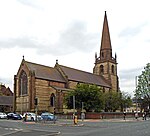Tue Brook House
1615 establishments in EnglandGrade II* listed buildings in LiverpoolHouses completed in 1615Merseyside building and structure stubs

Tue Brook House, 695 West Derby Road, Liverpool was built in 1615 as a farmhouse. It is now owned by a local family. It is thought to have been originally owned by John Mercer, a yeoman farmer and during the Victorian period was the home and workshop of a Mr.Fletcher, a wheelwright. Some parts of the building contain sections of its original "wattle and daub" construction, which can be seen through glass panels. Also containing a priest hide located in the chimney breast between two of the bedrooms. The house is currently owned by a local Liverpool family.
Excerpt from the Wikipedia article Tue Brook House (License: CC BY-SA 3.0, Authors, Images).Tue Brook House
West Derby Road, Liverpool Stoneycroft
Geographical coordinates (GPS) Address Nearby Places Show on map
Geographical coordinates (GPS)
| Latitude | Longitude |
|---|---|
| N 53.426323 ° | E -2.926392 ° |
Address
MILL BANK/LEISURE CENTRE
West Derby Road
L13 0BH Liverpool, Stoneycroft
England, United Kingdom
Open on Google Maps







